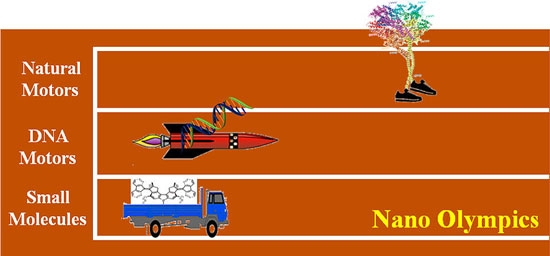| Posted: Sep 19, 2012 | |
Off to the races - artificial nanomachines are playing catch-up to nature's molecular motors |
|
| (Nanowerk Spotlight) A fast-growing body of nanotechnology research is dedicated to nanoscale motors and molecular machinery. Although applications of molecular motors are still in the future, the results of early-day studies are already spectacular: well-designed molecules or supramolecules show different kinds of motion – fueled by different driving forces such as light, heat, or chemical reactions – resulting in molecular shuttles, molecular elevators and rotating motors. Just a few weeks back we introduced the concept of a water-powered nanomotor. | |
| Before that we have shown other examples of researchers progress in developing self-propelled chemically-powered micro- and nanoscale motors: (read more: ""Another nanotechnology step towards 'Fantastic Voyage'"), microtube engines (read more: "Microbots transport, assemble and deliver micro- and nanoscale objects") or spherical Janus microparticles (read more: "Novel motor system powered by polymerization"). | |
| For the more visionary goals of nanotechnology – as opposed to today's nanotechnology applications that mostly deal with nanoscale materials used in coatings and composites – functional and perhaps autonomous molecular motors will play an essential part, just like electric motors can be found in many appliances today. These nanomachines could perform functions similar to the biological molecular motors found in living cells, things like transporting and assembling molecules, or facilitating chemical reactions by pumping protons through membranes (read more: "Are nanotechnology machines a match for nature's biomotors?"). | |
 |
|
| Nature's molecular motors and nanomachines perform marvelous tasks, especially on the level of single cells. Can artificial ones compete? You et al. demonstrate a photon driven molecular machine where switching the color of the light switches the direction of motion of the molecular motor. While having inferior performance characteristics, this novel motor may become the forerunner of a new generation of sophisticated and practical competitors with Nature's ancient, but highly important, nanomachines. (© ACS) | |
| In a contribution in the September 13, 2012 online edition of ACS Nano ("Racing with Nature: Artificial Nanomachines That Keep Running on Light, Both Left and Right"), Raoul Kopelman, Kasimir Fajans Collegiate Professor of Chemistry, Physics and Applied Physics at the University of Michigan, takes a look at what's happening in this field and focuses on a recent paper that reports a new light-powered DNA locomotion device. | |
| This walking device, reported in the same issue of ACS Nano ("Building a Nanostructure with Reversible Motions Using Photonic Energy"), is capable of autonomous and reversible motion along an oligonucleotide track. The direction of motion can be switched using different wavelengths of light. | |
| The authors say that, compared with other reported DNA walkers, this new strategy not only preserves the autonomous and controllable movement but also provides a reusable track, making it feasible to reset the device after the complete trip, as observed in nature for kinesin and myosin. | |
| They further write that "the principle of photoisomerization-induced toehold length switching could be further used in designing other autonomous DNA-based walking devices, where sequential and controllable release of the toehold is required. Moreover, as the first study (based on our knowledge) of using photoswitchable molecules for alternating the DNA toehold binding regions, this system can be employed for external control of the route selection in multi pathway systems, such as “crossing” or “T junction”, for more advanced walking devices that can rival molecular motors in nature." | |
| Notwithstanding all the progress that researchers make in this area, Kopelman points out that the record for DNA-based walkers is only around 100 nm or 13 steps. There is lots of room for improving not only the distance of artificial walking motors but also their speed and accuracy. | |
| With regard to the light-powered DNA walkers he notes that though they are more controllable now, stimuli-responsive or non-ATP-fueled walks are still mostly performed in a non autonomous way; that is, one has to add fuel step-by-step. "In this respect, light-powered machines have definite advantages. In the near future, various types of fuel-powered machines could appear, driven by magnetic, electric, ultrasound, or other forces. Moreover, chemically stimulated walkers (such as with ATP or cancer cell markers as stimuli) could be used in the future as “in situ fueled” devices, outperforming natural molecular motors, which require the ATP environment." | |
 By
Michael
Berger
– Michael is author of three books by the Royal Society of Chemistry:
Nano-Society: Pushing the Boundaries of Technology,
Nanotechnology: The Future is Tiny, and
Nanoengineering: The Skills and Tools Making Technology Invisible
Copyright ©
Nanowerk LLC
By
Michael
Berger
– Michael is author of three books by the Royal Society of Chemistry:
Nano-Society: Pushing the Boundaries of Technology,
Nanotechnology: The Future is Tiny, and
Nanoengineering: The Skills and Tools Making Technology Invisible
Copyright ©
Nanowerk LLC
|
|
|
Become a Spotlight guest author! Join our large and growing group of guest contributors. Have you just published a scientific paper or have other exciting developments to share with the nanotechnology community? Here is how to publish on nanowerk.com. |
|
